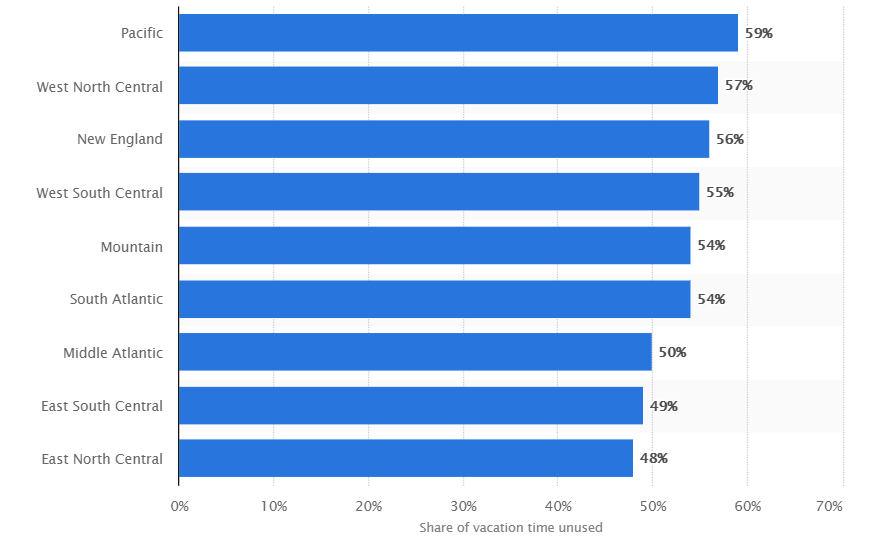
We spend close to 100,000 hours working over the course of our lifetime. Drawing on that inspiration, here are a few ideas to help you and your employees make the most of your summer vacation this year. But first, let’s look at the facts.
Annual Unused Vacation Time

Taking time off is difficult.
In fact, research shows that a significant portion of vacation time—up to nearly 60%— goes unused every year. This translates to over 600 million days per year of unused vacation time. Individually, that means the average employee only uses about half of their vacation time in a given year.1,2
The Cost of Unused Vacation Days
At first glance, the problem of unused vacation days may seem minor. But, it’s actually the opposite. Unused vacation time has multiple effects on various levels—personally, professionally, and nationally.
Personally
Vacation can have a significant positive impact on an individual’s health and well-being. For example, vacation can boost creativity, curb burn out, and strengthen personal relationships. According to experts, vacation time helps people recover from the kind of stressful work events that contribute to long-term, chronic health problems.3
Professionally
Vacation is important for our professional lives. According to the Society for Human Resource Management and U.S. Travel Association’s Vacation’s Impact on the Workplace Survey, most HR professionals believe that employees who take time off are more productive. They also believe vacation contributes to higher morale among employees and better employee retention rates.4
Nationally
Unused vacation time has recently cost our economy over $200 billion per year, and that’s mainly due to lost spending. When employees fail to use all their vacation time, spending drops, and the decline in spending has a major impact on the economy.1,2
In fact, Project Time Off reports that the amount of lost spending from unused vacation days in 2016 would have supported nearly 2 million jobs and created $70 billion in additional income.1,2
The bottom line is that when we don’t use all of our vacation days, it matters.
How to Encourage Employees to Take Advantage of Time Off
Before you can effectively encourage employees to take time off, you first need to understand why they don’t take time off.
Employees give up their time off for a variety of reasons, but usually it’s because they feel that their employer doesn’t want them to take time off.
So, even if you don’t discourage employees from taking time off, certain actions may still be sending the message that using vacation time is frowned upon.
To reverse this trend, we suggest making a concerted effort to make sure all your employees feel like they can take time off from work.
You can start by following these three strategies:
- Offer Flexible Time Off
Help workers overcome the temptation to fixate on accruing time off by offering flexible time off.
Flexible time off means employees can take time off whenever they need it without having to earn it or count it for fear of going over a limit.
Switching to flexible time off sends the message that breaks are a necessary part of work and should be taken as needed to keep productivity and happiness at optimal levels.
If your primary concern is that employees will abuse a flexible time off policy, you can stop worrying. Many companies find that regardless of the type of vacation policy offered, employees take roughly the same number of days off.5
It’s the mentality that surrounds time away from work that shifts, and that’s what you want. You want employees to take care of themselves, so they can be their best selves at work.
- Provide a Security Blanket That Supports More Summertime Fun
Another really good way to encourage employees to take time off and make the most of doing so is to let them know they’re okay in the event of an emergency.
Our product, the Ready For Life HSA, is such a security blanket. It offers an added layer of protection for summer fun and it shows employees that you care about their well-being.
The Ready for Life HSA is part of our mission to provide revolutionary HSA solutions and first-rate HSA admin for employers. It fills the gap between what employees have saved and what they owe when unexpected medical costs occur.
So, instead of draining their savings or racking up expensive credit card bills, employees get an interest free payroll advance to cover the expense. They then pay that advance back in small, manageable chunks that are automatically deducted from their paycheck.
To learn more about Ready for Life visit our Ready For Life for Employers Page.
- Switch to Summer Hours When Warm Weather Hits
Finally, you can always switch to summer hours when the warm weather hits.
Switching to summer hours for the months of June, July, and August gives employees the time off they need to refresh without the anxiety.
When the office closes early, everyone goes home. So, there’s no negative stigma attached to taking time off.
Employees are free to truly relax and refresh, and as a result, they’ll come back to work feeling better than ever.
Need Help?
The importance of vacation cannot be overlooked. Make sure employees feel supported to take the time away from work they need this summer and make the most of that time away. Give us a call today for additional help supporting your employees this summer when they take time off.
Sources:
1. https://projecttimeoff.com/reports/the-state-of-american-vacation-2017/
2. https://www.forbes.com/sites/kateashford/2017/05/31/vacation/#7b92b97b726a
3. http://www.worklife.emory.edu/workplaceflexibility/news/TheVacationDilemma.html
4. https://www.shrm.org/hr-today/trends-and-forecasting/research-and-surveys/Pages/shrm-us-travel-vacation-benefits.aspx
5. https://www.fastcompany.com/3052926/we-offered-unlimited-vacation-for-one-year-heres-what-we-learned
